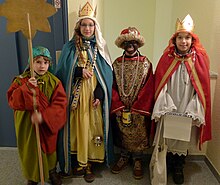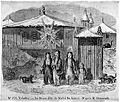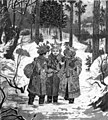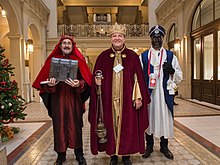Carol singers
A carol singer is a group of people - mostly children - of whom, according to custom, three are disguised as the Three Wise Men . Carolsinger groups move through the congregation from Christmas to the feast of the Epiphany on January 6th, put the carol singers blessing on the doors of houses and apartments, incense with incense and also collect money for charitable purposes. The legendary use of star singing can be traced back to the 16th century and is also known as Dreikönigssingen (regionally also Dreikönigsingen ).
history
The star singing goes back to the mention of the wise men or magicians in Mt 2.1 EU . In the sixth century, based on their three gifts gold, frankincense and myrrh ( Mt 2.11 EU ), three people were suspected. In the eighth century, the Magi became kings with the names Caspar , Melchior and Balthasar with reference to Isa 60,3 EU and Ps 72,10 EU . These kings were sometimes referred to and venerated as saints . Her relics have been in the Epiphany Shrine in Cologne Cathedral since 1164 . One of the kings is traditionally depicted as a Moor and has been interpreted as a representative of Africa since the Middle Ages, while the other two stood for Europe and Asia, the three continents known at that time, which thus all found the newborn child Jesus. For Beda Venerabilis (8th century) the three kings symbolized the three ages (youth, man, old man) and the three continents known at the time (Asia, Europe and Africa).
The origins of star singing are believed to be in the Epiphany . Carol singing developed differently in northern and southern Europe.
In the north, with the onset of Protestantism, the monastery schools lost their income as the governments took monastic land and goods for themselves. In times of need, the monastery students used the opportunity to collect donations by singing carols. In Norway , the custom is documented from 1563. In the following centuries caroling in Northern Europe was mainly practiced by monastery students. At the end of the 19th century, it was increasingly banned by the authorities as a form of begging and the practice almost died out in many places. In the 1920s, star singing reappeared in individual Scandinavian locations. It is mainly to be found in cities, rarely in the country.
In Central Europe , carol singing is a traditional custom in the Roman Catholic and Old Catholic Churches. Records of the St. Peter monastery in Salzburg prove the first carol singing in 1541. Evidence of carol singing can be found for 1550 in Wasserburg am Inn, 1552 in Laufen , 1569 for the Benedictine monastery Ettal and 1577 for Burghausen . Especially after 1560, carol singing became widespread and was combined with the singing at the feast of the Three Kings, which was common at that time, by school choirs. In some areas, star singing was only allowed to certain professional groups. The linen weavers had this right in Freising , the Salzach boatmen in Laufen and the bricklayers in the Munich suburb of Au at the time . In other areas, poor children and young people went from house to house on their own initiative, collecting natural produce and money for themselves and their families. In the Freising area it was forbidden by royal Bavarian decree on November 22nd, 1784, as the donations collected there were used up for beer in pubs and the carol singing was associated with greater noise. Nevertheless, the custom persisted.
Since the middle of the 20th century there have been centrally controlled caroling campaigns in Germany , Austria and Belgium . Most of the money is raised for development aid projects that help children in need around the world.
Carol singers in Bucharest , around 1840
Carol singers in Denmark , 1862
Carol singers in Austria , 1898
Carol singers in Russia , 1916
Central Europe
In Germany , Austria , Switzerland and the Italian regions of Trentino-South Tyrol and Friuli , the carol singing takes place today, organized primarily by Catholic communities. The carol singers are often children and adolescents, now usually accompanied by an adult, who, after being broadcast in the octave of Christmas until the Epiphany on January 6, possibly also on the following weekend, go from house to house dressed as the Three Kings. Traditionally and following Christian iconography , one of the magicians is disguised as a Moor . This has been criticized as falling under blackfacing .
Carol singers are sent out by the respective parish . Often a mission ceremony takes place in a church service . The carolers sing songs, say a prayer or recite a poem to the people who open the door for them or let them in. Then write the traditional blessing C + M + B with the respective year on the front doors or the door beams with consecrated chalk . The blessing is a sacramental . There are also adult carolers, for example when performing in public places, in facilities with night shifts or in bars.
In Germany and Switzerland, the organizing organizations recommend the spelling “20 * C + M + B + 20” for the current year. According to the Kindermissionswerk, this spelling has the following meaning: a star for the star of Bethlehem and the three crosses for the triune God . In Austria and South Tyrol, the spelling “20-C + M + B-20” with another cross above the letter M is used. In addition, there are regionally different other traditional spellings in which only two crosses ("20 * C + M + B * 20", "20 C + M + B 20", "20 + CMB + 20") or four crosses ("20 + C + M + B + 20 “).
The meaning of the letters C, M and B has been interpreted as an abbreviation of the Latin words "Christ mansionem benedicat" (= "Christ bless this house") since the 1950s at the latest . The inscription is intended to call down God's blessing on the house and its inhabitants and protect them from misfortune. Earlier sources of this interpretation are missing. In older folklore treatises the interpretation of the letters as the initials of the three kings Caspar, Melchior and Balthasar predominates. This is corroborated by the fact that in some regions the spelling "K + M + B" is common. When using this spelling, the "K" is interpreted as an abbreviation for the Greek word for "Lord" (κύριος, "Kyrios") ("Kyrios mansionem benedicat").
Germany

The carol singing campaign is also known in Germany as the “Dreikönigssingen” and is the world's largest organized aid campaign by children for children. Since 2003, "the overall context of the Dreikönigssingen campaign (including the name and logo) has been protected by copyright ."
In the first caroling campaign in 1959, carolers participated in 100 parishes and collected 90,000 marks (inflation-adjusted in today's currency: around 213,000 euros). The Federation of German Catholic Youth (BDKJ) has been involved in the campaign since 1961 , which has since been supported jointly by the children's missionary organization “Die Sternsinger” and the BDKJ. In 2005, 12,743 parishes and groups with around 500,000 children and 80,000 carers took part in the campaign. A new record for donations was reached in Germany with around 47 million euros. The donations collected during the campaign provide sustainable support for aid projects that benefit children in need worldwide.
Traditionally, the carol singers are also received by the Federal President in Bellevue Palace , by the Federal Chancellor in the Federal Chancellery and by other members of the Federal Government in their ministries . In 2004 the carol singers were awarded the International Peace of Westphalia Prize.
In the meantime (2018) the interest in participating has decreased, in some communities you have to order the carol singers.
Italy
In South Tyrol , in Trentino (Welschtirol) and in Friuli the carol singing campaign is organized by the Catholic Young Group of South Tyrol together with Missio Bozen - Brixen . The donations are used to support church projects in Africa , Asia , Latin America , Eastern Europe and Oceania .
Austria
The Slovenian Salesian Father Janez Rovan is one of the "founders" of modern star singing in Austria . At the suggestion of the pastor at the time in Globasnitz in Jauntal ( Carinthia ), the idea of the Three Kings Singing was launched in 1946 for the benefit of the needy. In Vienna , the civil servant Franz Pollheimer founded the tradition of star singing in the big city in 1946/1947, collecting for social purposes, for the reconstruction of St. Stephen's Cathedral and for the mission (MIVA = Missions-Verkehrs-Arbeitsgemeinschaft). The presence of the Viennese carol singers in the media and in public - around 1951/1952, thousands of Viennese accompanied the group on the way to St. In 1949, Franz Sommer began preparing for the Epiphany in Styria.
The Austrian Catholic Youth Group has been organizing carol singing since 1954 . The Dreikönigsaktion, the aid organization of the Catholic youth group, manages the collected donations and supports around 500 projects in 20 countries in Africa, Asia and Latin America every year. Today, around 85,000 carol singers proclaim the good news , bring blessings to homes and collect donations. The 64th caroling campaign in 2018 raised 17.5 million euros. These donations benefit more than one million people in Africa, Latin America and Asia; a total of 435 million euros have been donated to the carol singers since 1954. In Austria, the Dreikönigsaktion is meanwhile the largest annual relief operation.
During the Heiligenblut carol singing, whose roots go back to the 16th century, on the night of January 5th to 6th, adult villagers move from house to house in so-called “rotten” to perform the traditional twelve-stanza caroling song in every house. The donations collected during the night are distributed to those in need. This custom and the carol singing in the Villgratental were added to the register of intangible cultural heritage in Austria in 2010 . In Germany, carol singing was added to the list of intangible cultural heritage in 2015 .
Switzerland
In the Historical Dictionary of Switzerland Paul Hugger writes:
“On the eve of Epiphany, the Feast of the Three Kings (January 6th), houses were blessed in rural areas and the lintel was marked with the letters C + M + B (Christ mansionem benedicat), popularly as the first letters of the Three Kings (Caspar, Melchior, Balthasar ) interpreted (tradition from the 7th century). Star singing, which has experienced a renaissance in many places since the 1930s, is widespread across all language areas. The "bean king" (in France since the 10th century, in Switzerland especially in the Jura), which has been propagated by the Swiss Association of Bakers and Confectioners since 1953 (Dreikönigskuchen), brings a distant echo of the old customs. The 6.1. is also a start date of the carnival (Schwyz with Greiflet and bell). "
Star singing was revived in Switzerland in 1989 and has been carried out by missio ever since . The solidarity fund "Children Help Children" and an annually changing project of the Children's Mission are supported .
In the Swiss canton of Lucerne , the star singers carried a large star, which was carried by the “star turner”. The song, which was performed by the star singers, It has arrived at a time for us was therefore called the “Sterndreherlied”.
Slovakia
The biggest carol singing campaign in Slovakia is Dobrá Novina (German: "Happy News"). Dobrá Novina is also one of the largest young people's charities in Slovakia. Dobrá Novina is carried out by the youth association eRko .
Slovenia
In Slovenia , the carol singers perform a kind of nativity play after the New Year , which is fun. In one scene the shepherds are sleeping in the field, snoring. They are woken up with a deafening drumbeat. The game ends with music and dance, in which the audience also takes part. Finally, Balthasar writes “K + M + B” in chalk and writes the year over the door.
Czech Republic
In the Czech Republic , the local Caritas carries out a “Three Kings Collection”, whereby a large part of the proceeds are used for charitable purposes in the respective region. The collection in 2018 achieved a record result of 112 million crowns (four million euros).
In Scandinavia today, carol singing takes place in different forms:
- In Norway (stjernespill) as a Singspiel in kindergartens, schools and churches, where usually no money is collected.
- In Sweden (stjärngossar) carolers take part in Lucia processions on December 13th today. This also gives boys the opportunity to participate.
- In Finland (tiernapojat) there are three children who play Kaspar, Melchior and Balthasar, and the fourth character is Herod . There is a mock fight with swords.
Great Britain
In the United Kingdom , in addition to the star singers, there is also the custom of the so-called Star boys' singing procession . This does not carry a star in front of it, but lanterns with a candle and does not go to private houses, but to the pubs , where the singers receive free beer as a thank you.
Spain and Mexico
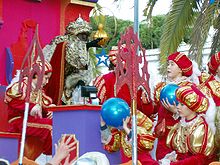
In Spain and parts of Mexico , the Cabalgata de Reyes Magos traditionally takes place on the evening of January 5th . The three wise men drive through the streets in magnificent carriages. Their servants throw candy to children. Before going to bed the children clean their shoes. On the morning of January 6th, they'll find gifts from the three wise men - or coal, if they were naughty in the past year. This custom is similar to the Central European Nicholas customs.
Carol Singers (selection)
- The holy three kings with their star , text and melody: handed down from Upper Bavaria, early 18th century.
- The legend of the three wise kings , text: Rolf Krenzer , melody: Ludger Stühlmeyer , ZDF star singers campaign 1999.
- The wise men from the Orient , text and melody: Kurt Rommel .
- Three kings led God's hand , text: Friedrich Spee , melody: Cologne 1880.
- With your graces, Lord Jesus, fill this house (a child is born to us), Leipzig 1884.
- A time has come for us , Swiss folk tune, in the middle of the 19th century.
- From a great distance, three kings parade , folk tune from the Styrian Salzkammergut.
- God griaß enk Laidln ollesombt, megn sai so fü enk woin
- Bright star in the dark night , text: Diethard Zils , melody: France 1874 ( Il est né le divin enfant ) .
- Here come the kings, they follow a star , text: Rolf Krenzer, melody Peter Janssens .
- Now see the star we bring , text: Georg Thurmair, melody: Adolf Lohmann.
- See the star that we bring you , text: Peter Gerloff , melody: Ludger Stühlmeyer.
- Do you see our star there , text: Diethard Zils, melody: France 18th century ( Les Anges dans nos campagnes ) .
- Star over Bethlehem , text and melody: Alfred Hans Zoller 1964.
- We holy three kings with our star , folk tune.
- We therefore come from the Orient , text: Maria Ferschl , melody: Heinrich Rohr .
- We are the three kings , text and music: Kurt Mikula.
literature
- Becker-Huberti, Manfred : The Three Kings. Stories, legends and customs . Greven Verlag, Cologne. ISBN 3-7743-0356-8 .
- Elfriede Grabner: The Three Kings Blessing C + M + B and its christological reinterpretation. On the change of a custom symbol as an innovation of the 20th century. in: Blätter für Heimatkunde. ed. from the Historical Association for Styria . 85th year, no. 1. Graz 2011 pp. 3–12
- Schweizerisches Idiotikon Volume III Columns 331–334: Article Drei Chüng (e) , with a lot of information on older star singing (and its abuse) in Switzerland.
Web links
- Website of the children's mission organization “Die Sternsinger” in Germany
- Dreikönigsaktion the cath. Young group Austria
- Carol singers campaign in Switzerland
Individual evidence
- ↑ Manfred Becker-Huberti : Celebrations, festivals, seasons. Living customs all year round. Herder Verlag, special edition, Freiburg im Breisgau 2001, ISBN 3-451-27702-6 , p. 169.
- ^ Johann Maier: The Epiphany was called "Great New Year". Carol singing used to serve to secure the livelihood of various professional groups. In: Moosburger Zeitung , January 5, 2013, p. 29.
- ^ Catholic-kirche-meckenheim.de, December 2, 2016 ( memento of January 2, 2017 in the Internet Archive ), accessed on January 2, 2017.
- ↑ http://www.kirchenweb.at/christkind/heiligen_drei_koenige/heiligendreikoenige.htm .
- ↑ What white people do not want to hear about racism but should know (unabridged). Retrieved July 17, 2020 .
- ↑ Young people and adult carolers. ( Memento from November 23, 2013 in the Internet Archive ) In: dka.at , accessed on November 23, 2013.
- ↑ Sternsingen / CMB ( page no longer available , search in web archives ) Info: The link was automatically marked as defective. Please check the link according to the instructions and then remove this notice. . Status: January 8, 2008 (pdf)
- ^ Regulations for the Dreikönigssingen campaign, resolved by the permanent council of the German Bishops' Conference. Children's mission organization “Die Sternsinger”, Association of German Catholic Youth, Aachen 2003, p. 6, § 1.
- ↑ Who we are - The Carol Singers. In: The carol singers. Retrieved August 18, 2016 .
- ↑ Incense to order
- ↑ The caroling action. ( Memento of January 13, 2009 in the Internet Archive ) missio Bozen-Brixen
- ^ History of carol singing in Styria on the website of the Catholic Church of Styria, accessed on December 28, 2013.
- ↑ Austria's carol singers collected almost 17.5 million euros. In: Tyrolean daily newspaper. April 4, 2018, accessed March 5, 2020 .
- ^ Austria: carol singers on the go again. Vatican Radio
- ↑ Heiligenbluter Sternsinger ( memento from February 1, 2014 in the Internet Archive ) , National Agency for Intangible Cultural Heritage, Austrian UNESCO Commission.
- ↑ German Unesco Commission e. V. - Star singing . Retrieved December 5, 2015
- ^ Paul Hugger: Church year. In: Historical Lexicon of Switzerland . December 2, 2008 , accessed June 5, 2019 .
- ↑ Missio Switzerland: Carol Singing ( Memento from August 15, 2007 in the Internet Archive )
- ↑ On Swiss star singing in older times (and its excesses) see Schweizerisches Idiotikon Volume III, columns 331–334, article Drei Chüng (e) .
- ↑ History of the star turning song "A time has arrived for us".
- ↑ See Schweizerisches Idiotikon , Volume XIV, Column 713, Article Stërn-Drǟ (i) jer ( digitized version ). The name is also known elsewhere, see German Dictionary , Volume XVIII, Column 2487, Article Sterndreher ( digitized ).
- ↑ Jančovič, J, Fialová, Z and O'Mullane, M (2015): Development Education at University Level in Slovakia: Experiences and Challenges. ( Memento of September 28, 2015 in the Internet Archive ) Vol. 20, Spring, pp. 166-185
- ↑ Completion of the Epiphany Catholic Church in the Czech Republic on February 1, 2018.
- ↑ Maria Palmer: Perceiving the signpost. The Epiphany song "See the star that we bring you" by Peter Gerloff and Ludger Stühlmeyer. In: Heinrichsblatt, No. 1, Bamberg January 1, 2017, p. 13 .
- ^ In: Gotteslob , No. 262, Katholische Bibelanstalt Stuttgart 2013.
